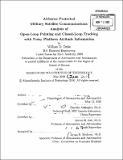Airborne protected military satellite communications : analysis of open-loop pointing and closed-loop tracking with noisy platform attitude information
Author(s)
Deike, William D
DownloadFull printable version (21.99Mb)
Alternative title
Analysis of open-loop pointing and closed-loop tracking with noisy platform attitude information
Other Contributors
Massachusetts Institute of Technology. Department of Aeronautics and Astronautics.
Advisor
Timothy Gallagher and Steven R. Hall.
Terms of use
Metadata
Show full item recordAbstract
U.S. military assets' increasing need for secure global communications has led to the design and fabrication of airborne satellite communication terminals that operate under protected security protocol. Protected transmission limits the closed-loop tracking options to eliminate pointing error in the open-loop pointing solution. In an airborne environment, aircraft disturbances and noisy attitude information affect the open-loop pointing performance. This thesis analyzes the open-loop pointing and closed-loop tracking performance in the presence of open-loop pointing error and uncertainty in the received signal to assess hardware options relative to performance requirements. Results from the open-loop analysis demonstrate unexplained harmonics at integer frequencies while the aircraft is banked, azimuth and elevation errors independent of the inertial pointing vector and aircraft's yaw angle, and uncorrelated azimuth and elevation errors for aircraft pitch and roll angles of +/-10° and +/-30°, respectively. Several conclusions are drawn from the closed-loop tracking analysis. The distribution of the average noise power has a stronger influence than the distribution of the received isotropic power on the signal-to-noise ratio distribution. The defined step-tracking algorithm reduces pointing error in the open-loop pointing solution for a pedestal experiencing aircraft disturbances and random errors from the GPS/INS. The rate of performance improvement as a function of the number of hops is independent of the antenna aperture size and the GPS/INS unit. Pointing performance relative to the HPBW is independent of the antenna aperture size and GPS/INS unit for on-boresight, but not for off-boresight. With signal-to-noise ratios averaged over 100 hops and pointing biases less than or equal to 0.5 the half-power beamwidth, the step-tracking algorithm reduces the pointing error to within 0.1 the half-power beamwidth of the boresight, for all tested configurations. The overall system performance is bounded by the open-loop pointing solution, which is based on hardware selection. Closed-loop tracking performance is a function of the number of sampled hops and is for the most part independent of the hardware selection.
Description
Thesis: S.M., Massachusetts Institute of Technology, Department of Aeronautics and Astronautics, 2010. Cataloged from PDF version of thesis. Includes bibliographical references (pages 159-162).
Date issued
2010Department
Massachusetts Institute of Technology. Department of Aeronautics and AstronauticsPublisher
Massachusetts Institute of Technology
Keywords
Aeronautics and Astronautics.